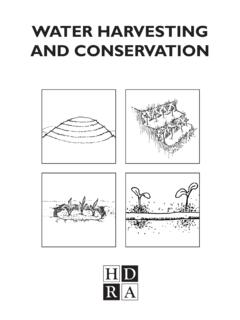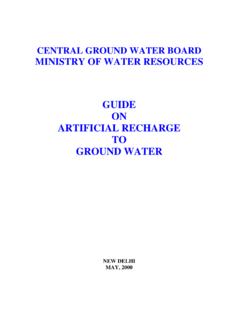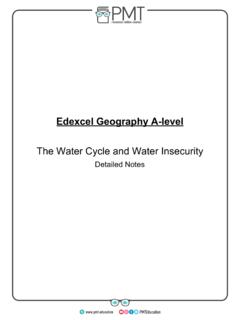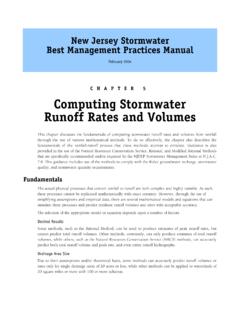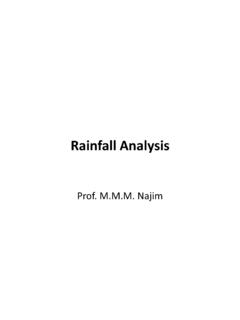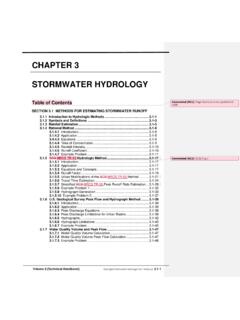Transcription of Inherent Factors Affecting Soil Infiltration
1 soil Infiltration refers to the soil 's ability to allow water movement into and through the soil profile. It allows the soil to temporarily store water, making it available for uptake by plants and soil organisms. Infiltration rates are a measure of how fast water enters the soil and are typically expressed in inches per hour. For initial in-field assessments, however, it is more practical to express Infiltration time in the number of minutes it takes soil to absorb each inch of water applied to the soil surface. Water entering too slowly may lead to ponding on level fields, erosion from surface runoff on sloping fields, or inadequate moisture for crop production.
2 An adequate amount of water must infiltrate the soil profile for optimum crop production. Porous soils allow water to infiltrate and recharge ground-water aquifers and sustain base flow in streams. An Infiltration rate that is too high can lead to nitrate-nitrogen or pesticide leaching, if they are not managed correctly. Management measures, such as residue management, cover crops can improve Infiltration . Inherent Factors Affecting soil Infiltration Inherent Factors Affecting soil Infiltration , such as Depending on the amount and type of clay soil texture, cannot be changed.
3 soil texture minerals, some clayey soils develop shrinkage (percentage of sand, silt, and clay) is the major cracks as they dry. The cracks are direct conduits Inherent factor Affecting Infiltration . Water moves for water entering the soil , causing clayey soils to more quickly through large pores of sandy soil than have high Infiltration rates under dry conditions. it does through small pores of clayey soil , especially Where cracks do not occur, clayey soils have slow if clay is compacted and has little or no structure or Infiltration rates. aggregation. Infiltration Management Management practices (such as providing ground or impervious soil layers have less pore space and cover and managing equipment traffic to avoid restrict water movement through the soil profile.)
4 Compaction) impact Infiltration by Affecting surface As soil moisture levels increase, Infiltration rates crusting, compaction, and soil organic matter. decrease. soil moisture is impacted by water Without a protective vegetative or residue cover, uptake by plants, residue and vegetative cover, bare soil is subject to direct impact and erosive irrigation practices, and drainage measures. Dry forces of raindrops that dislodge soil particles. soils tend to have pores and cracks that allow Dislodged soil particles fill in and block surface water to enter faster than wet soils.
5 As soils pores, contributing to the development of surface become wet, Infiltration rate slows to a steady rate crusts which restrict water movement into the soil . based on how fast water can move through the Compaction can result from equipment traffic, most restrictive layer, such as a compacted layer, especially on wet soils, and tillage pans. Compacted or a layer of dense clay. Page 1 Guides for Educators soil Infiltration soil Quality Kit USDA-NRCS. soil organic matter binds soil particles together in Using designated field roads or rows for stable aggregates, increasing porosity and equipment traffic Infiltration .
6 Soils with a high content of organic Reducing the number of trips across the field matter also provide good habitat for soil biota, such as earthworms. soil biota increase pore space Subsoiling to break up existing compacted layers and create continuous pores linking surface soil layers to subsurface soil layers. Using continuous no-till Long-term solutions for maintaining or improving Adding solid manure or other organic materials soil Infiltration include practices that increase Using rotations with high-residue crops, such as organic matter content and aggregation and corn and small grain, and perennial crops, such as minimize runoff , soil disturbance, and compaction.
7 Grass or alfalfa Increases in organic matter content result in increased aggregation and improved soil structure, Planting cover crops and green manure crops which lead to improved Infiltration rates. Farming on the contour Measures that can improve Infiltration rates: Establishing terraces or other runoff - and Avoiding soil disturbance and equipment erosion-control structures operation when soils are wet Problems Related to Infiltration and Relationship of Infiltration to soil Function When rainfall occurs at a rate that exceeds the and soil , resulting in decreased soil productivity, soil 's Infiltration capacity, runoff moves downslope offsite sedimentation of water bodies, and or ponds on the surface of level land.
8 When runoff diminished water quality. Tables 1 and 2 show, for occurs on bare or poorly vegetated soil , erosion periods of 1 year to 100 years, rainfall frequencies, occurs. runoff carries away nutrients, chemicals, duration of rainfall events, and inches of rainfall . Table 1. rainfall intensity and duration patterns for Mead, NE.*. Frequency Duration of rainfall Event (inches of rain). 30 minutes 1 hour 2 hours 1 year 2 years 5 years 10 years 100 years * Herschfield, rainfall Frequency Atlas of the , Weather Bureau, 1961. Page 2 Guides for Educators soil Infiltration soil Quality Kit USDA-NRCS.
9 Table 2. rainfall intensity and duration patterns for North Platte, NE.*. Frequency Duration of rainfall Event (inches of rain). 30 minutes 1 hour 2 hours 1 year 2 years 5 years 10 years 100 years * Herschfield, rainfall Frequency Atlas of the , Weather Bureau, 1961. Restricted Infiltration and ponding result in poor Table 3. Steady Infiltration rates for general soil soil aeration. This leads to poor root function, poor texture groups in a very deeply wetted soil (Hillel, plant growth, reduced availability of nutrients to 1982). (Only use these values to compare plants, and reduced cycling of nutrients by soil Infiltration rates to the second inch of water.)
10 Organisms. soil Type Steady Infiltration rate (inches per hour). Infiltration rate is most affected by conditions near Sands > the soil surface and can change drastically Sandy and silty soils - according to management. Infiltration is rapid Loams - through large continuous pores at the soil surface Clayey soils - and slows as pores become smaller. Steady-state Sodic clayey soils < Infiltration rates typically occur when soil is nearly saturated and are listed for varying textural classes in Table 3. These are average values and should not be generalized for all soil types.










